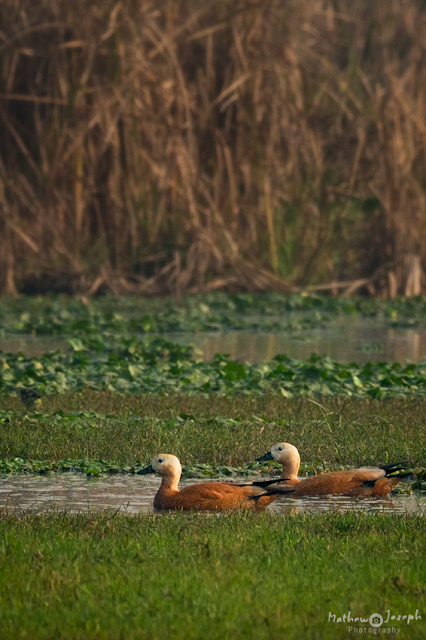Ruddy shelduck (Tadorna ferruginea) is a medium sized migratory
bird, easily identified by its orange-brown body and whitish-buff head. These
birds have an extensive range from southern Europe to much of Asia. They mostly
winter in the Indian sub-continent. They are also found to breed in high
altitude lakes of Jammu and Kashmir.
Ruddy Shelducks, Basai wetlands near Gurgaon
As such, these birds are fairly common across northern India
from October to April, and are found near large water bodies, swamps and
rivers. They are less common in South India. They are very good swimmers, but
are not much dependent on water for breeding as other ducks. Males and females
are mostly similar, though the male has a black ring at the base of its neck,
and the females a white patch on its head, during the breeding season.
Ruddy Shelducks fly over Surajpur Bird Sanctuary, Greater Noida
These nocturnal birds are omnivorous and feed on vegetation
such as shoots and seeds, as well as small fish, shrimp, insects, etc. They are
usually found in pairs or small flocks, but can also be found in large
congregations especially during the moulting period. They nest in holes in sand
or by the banks of rivers, burrows of trees or even abandoned buildings,
usually a bit far from water. These birds avoid coastal waters or places with
thick vegetation, preferring open spaces for roosting.
With global populations between 150,000 to 300,000, the Ruddy shelduck is categorized as “Least Concern” by IUCN. There is no evidence that the size of these birds are shrinking. Threats are few, and safe from hunting, as they are considered holy in many Asian countries.
Ruddy Shelducks, Keoladeo Bird Sanctuary, Bharatpur
With global populations between 150,000 to 300,000, the Ruddy shelduck is categorized as “Least Concern” by IUCN. There is no evidence that the size of these birds are shrinking. Threats are few, and safe from hunting, as they are considered holy in many Asian countries.
Ruddy Shelduck at Surajpur Bird Sanctuary, Greater Noida
I have sighted these birds at almost all the water bodies I
have visited during the winters. Most images are from Surajpur Bird Sanctuary
in Greater Nodia, Uttar Pradesh and Basai wetlands near Gurgaon, Haryana. These birds are a beauty
to behold, either in water or in flight with their striking colors.




No comments:
Post a Comment